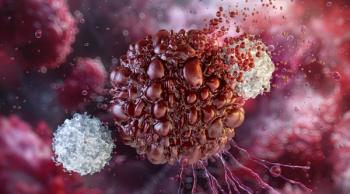
Call for New Treatment Approaches in Acute Myeloid Leukemia
Two researchers from the Mayo Clinic have published an editorial calling for new approaches in the treatment of AML, arguing that "using the same old drugs in different doses or different schedules is not going to cut it."
Two researchers from the Mayo Clinic in Rochester, Minnesota, have
The two researchers, Ayalew Tefferi, MD and Louis Letendre, MD, wrote the editorial as a response to the publication of a trial that evaluated whether the addition of an infusion of cladribine or fludarabine to a standard chemotherapy induction improves outcomes for adults with AML. The phase III results are
While there was no difference in early outcomes among the DAF and DA arms, complete remission rates were higher in patients who went through the DAC regimen (67.5% vs 56%; P = .01). This was due to lower incidence of resistant disease among the patients treated with the DAC regimen compared to the DA regimen (21% vs 34%; P = .004). Long-term outcomes were not significantly different for either the DAF or DA arms, nor were the toxicities experienced by patients. The authors concluded that adding cladribine to standard induction resulted in increased complete remission rates and improved overall survival for adult AML patients.
Current management of AML includes chemotherapy followed by cycles of consolidation chemotherapy. This 7 + 3 regimen is the standard induction for newly diagnosed AML patients and the most widely used chemotherapy regimen. The patient receives cytarabine for 7 days and daunorubicin for the first 3 days. An allogeneic stem-cell transplantation (SCT) post-induction is also an option.
The complete response rate for the 7 + 3 regimen ranges from 53% to 58% and is slightly higher in patients under 60 years of age. Long-term response is generally achieved by 15% of patients. According to Drs. Tefferi and Letendre, addition of a third agent-including etoposide, P-glycoprotein modulator, or gemtuzumab ozogamicin-has not resulted in added benefit.
The editorial states that there was an apparent advantage of DAC among patients with an unfavorable karyotype and possibly also for those patients who had a favorable karyotype in this new phase III study. Based on this trial and others, Drs. Tefferi and Letendre believe that the 7 + 3 regimen is no longer enough for long-term remission in non-M3 AML.
"Using the same old drugs in different doses or different schedules is not going to cut it," said Dr. Tefferi. "Adding equivocally effective drugs to current regimens is unlikely to change anything."
Dr. Tefferi would like to see new agents, including immunotherapies that have the potential to produce better outcomes for patients. "What we need is novel drugs with truly impressive activity or an immunotherapeutic approach that somewhat mimics what has been accomplished with allogeneic stem-cell transplantation," he said.
Dr. Tefferi believes that stem-cell therapies and immunotherapies are the most promising next-generation treatments for AML. In their editorial Drs. Tefferi and Letendre highlight results from recent studies: an elderly, newly diagnosed AML patient population that was
"We need to admit that we have not significantly improved the outcome of high-risk AML, especially as defined by cytogenetic findings," said Dr. Tefferi. He would like to see more patients participate in clinical trials to drive improvements in therapies. "These patients must be encouraged to participate in clinical trials that utilize truly novel drugs or immunotherapeutic approaches rather than most other trials which use the same drugs with minor modifications or additions of unconvincingly effective drugs." Whether or not the high-risk AML patient population will increase due to new
References
1. Tefferi A, Letendre L. Going Beyond 7 + 3 Regimens in the Treatment of Adult Acute Myeloid Leukemia. J Clin Oncol. 2012 Apr 23. [Epub ahead of print]
2. Holowiecki J, Grosicki S, Giebel S, et al. Cladribine, But Not Fludarabine, Added to Daunorubicin and Cytarabine During Induction Prolongs Survival of Patients With Acute Myeloid Leukemia: A Multicenter, Randomized Phase III Study. J Clin Oncol. 2012 Apr 16. [Epub ahead of print]
3. Guo M, Hu KX, Yu CL, et al. Infusion of HLA-mismatched peripheral blood stem cells improves the outcome of chemotherapy for acute myeloid leukemia in elderly patients. Blood. 2011;117:936-941.
4. Curti A, Ruggeri L, D'Addio A, et al. Successful transfer of alloreactive haploidentical KIR ligand-mismatched natural killer cells after infusion in elderly high risk acute myeloid leukemia patients. Blood. 2011;118:3273-3279.
Newsletter
Stay up to date on recent advances in the multidisciplinary approach to cancer.
































































































